The LG G3 Review
by Joshua Ho & Anand Lal Shimpi on July 4, 2014 5:00 AM EST- Posted in
- Smartphones
- LG
- Mobile
- Laptops
- G3
CPU Performance
By now, the Snapdragon 801 is mostly well-understood. It has four Krait 400 cores at either 2.26 or 2.45 GHz, an Adreno 330 at 578 MHz, a faster ISP, DSDA support, and higher clocks on the memory interface, along with support for eMMC 5.0 for faster NAND speed. However, OEM design choices can have significant effects on the relative performance of a device. For example, the Galaxy S5 trailed behind the HTC One (M8) despite a faster SoC due to worse thermal dissipation. This was because water resistance necessitated a new design that effectively encased the SoC in a polycarbonate cage, trapping heat in. The LG G3 has the same SoC and same build materials as the Galaxy S5, but the midframe is magnesium, not polycarbonate. This means that peak performance can be higher than the Galaxy S5.
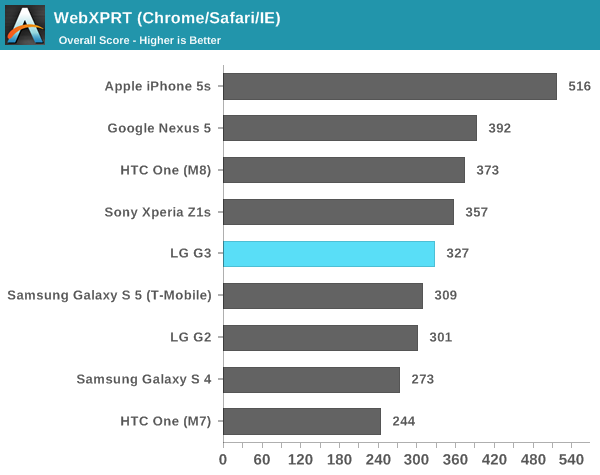
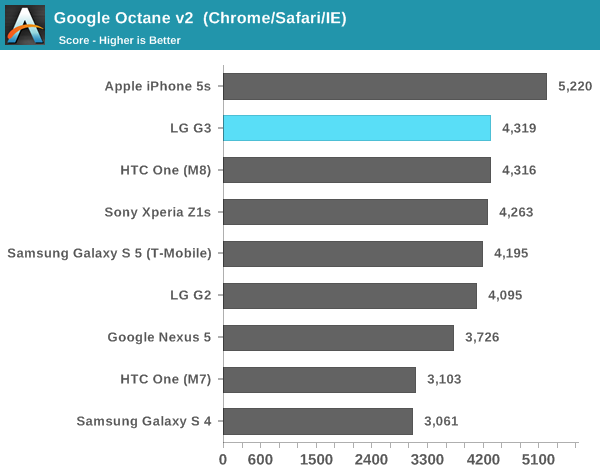
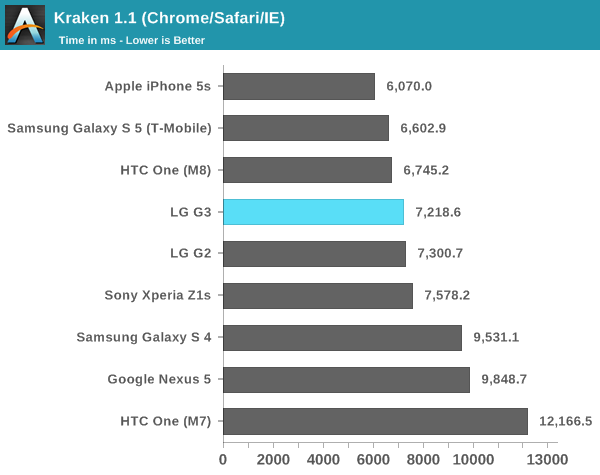
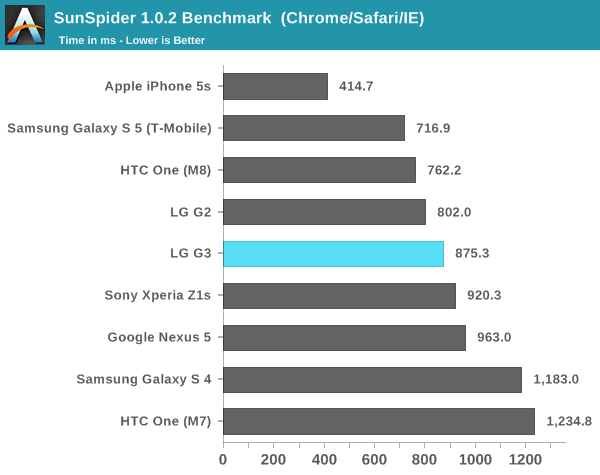
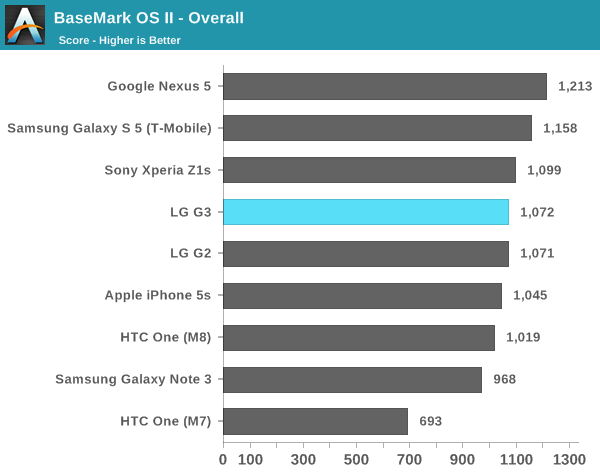
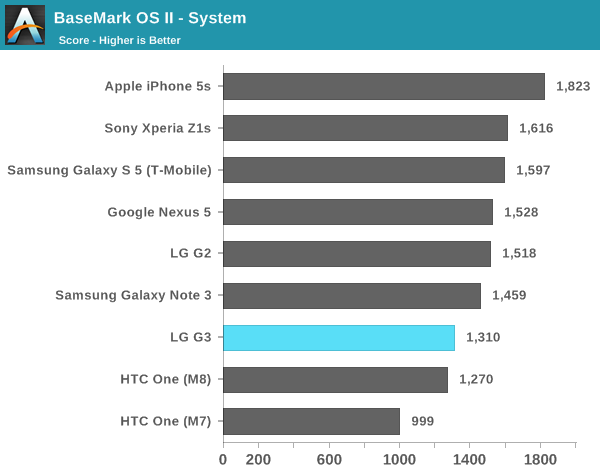
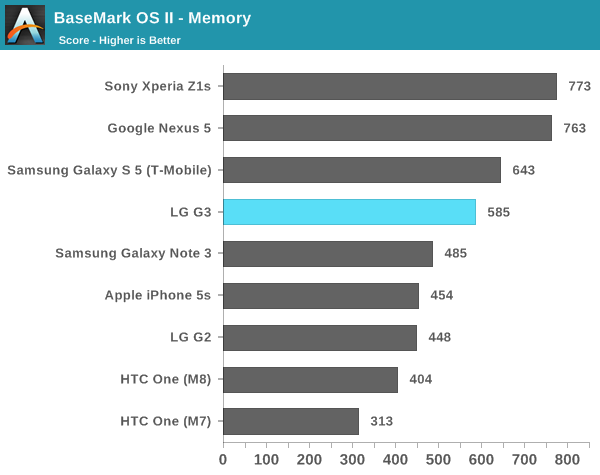

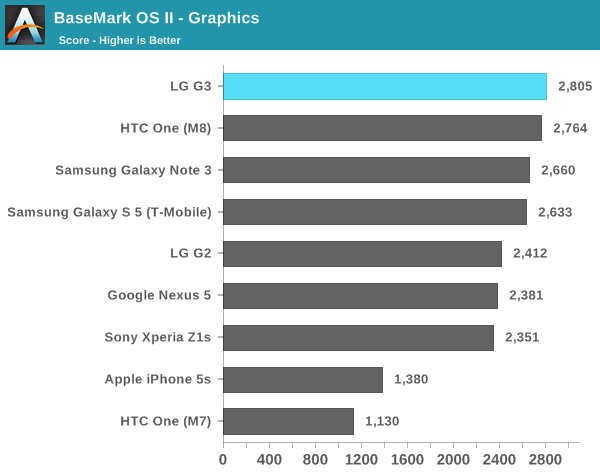
Relatively speaking, there's not much in the way of interesting things to talk about here, despite the new configuration. The G3 seems to trail the other S801 devices in web performance but it seems to depend upon the benchmark. This seems to be partially because of the G3's willingness to throttle, or because of the display's heat output. Either way, the trend is clear because of how often the display brightness is capped to 90 or 95 percent of the maximum to cool off the phone. When this isn't an issue though, the short benchmarks tend to show the faster performance of the G3.
GPU Performance
While the state of CPU benchmarking is heavily subject to difference in the performance of the web browser, things are a bit better in the GPU side. All Snapdragon 801 SoCs have the same GPU clocks, so this means that it'll be much easier to examine throttling behavior and reduce variability due to confounding factors.
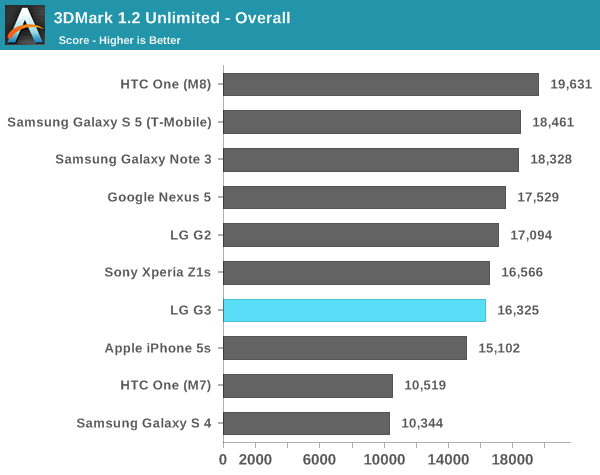
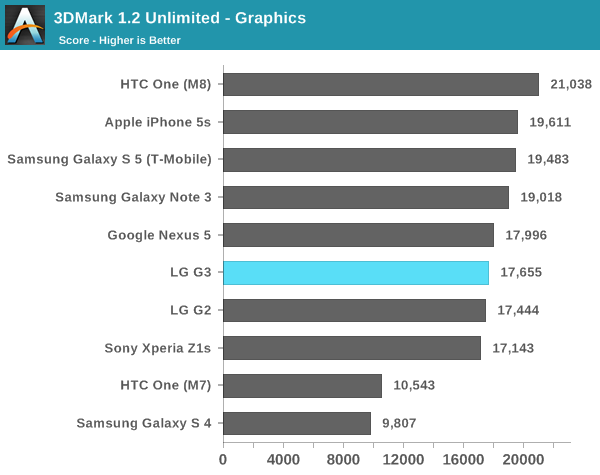

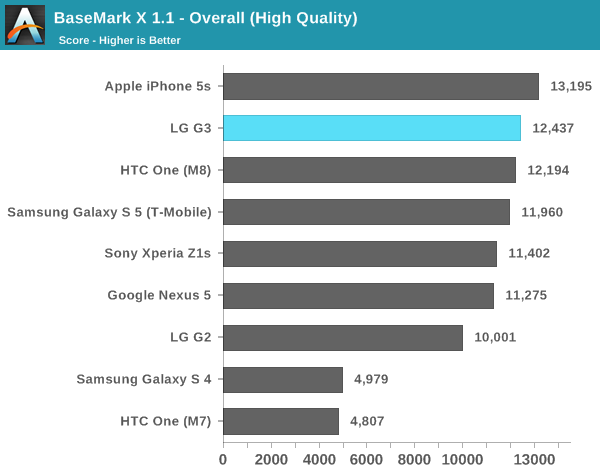
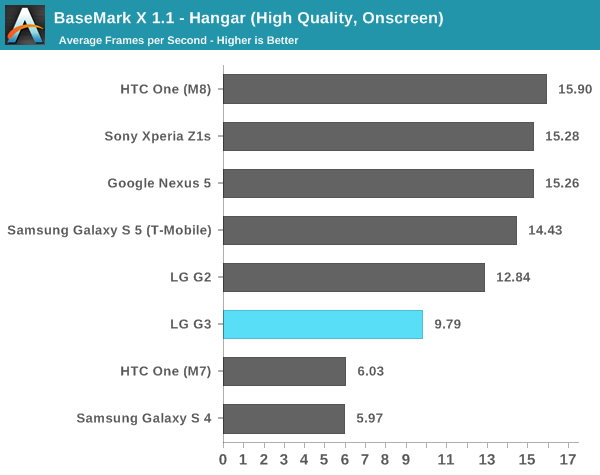
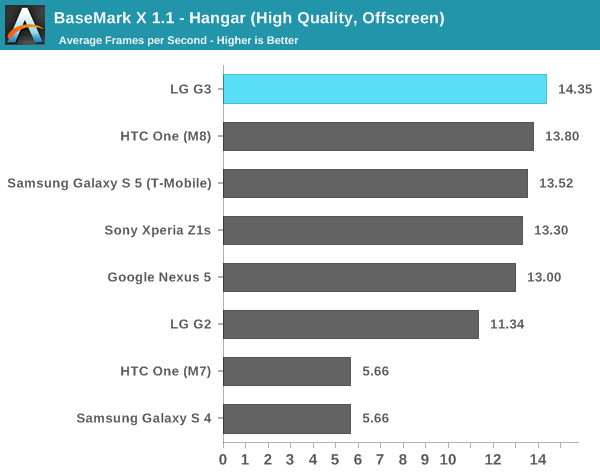
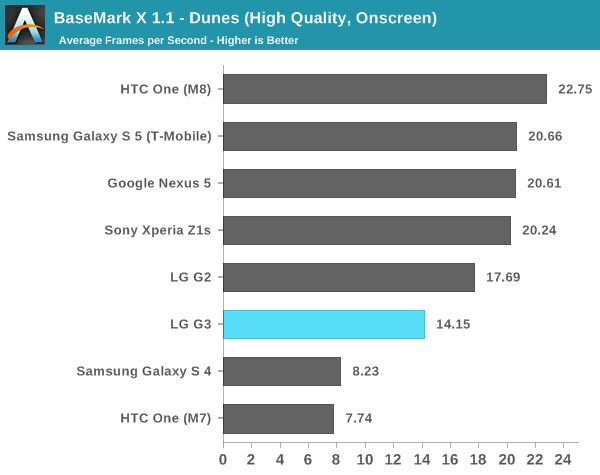
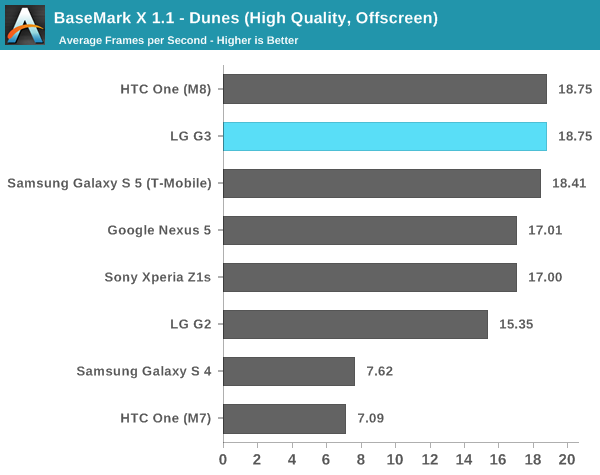
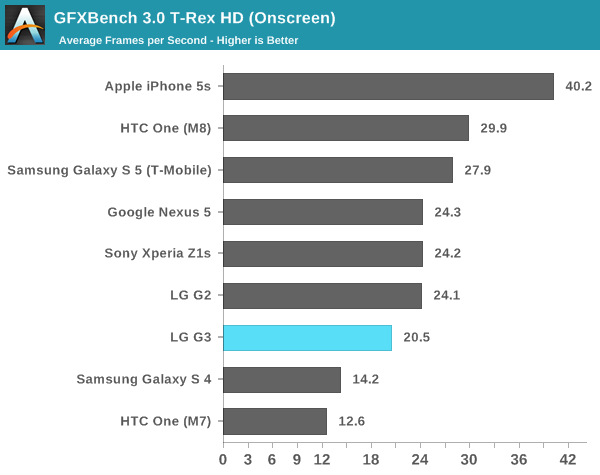
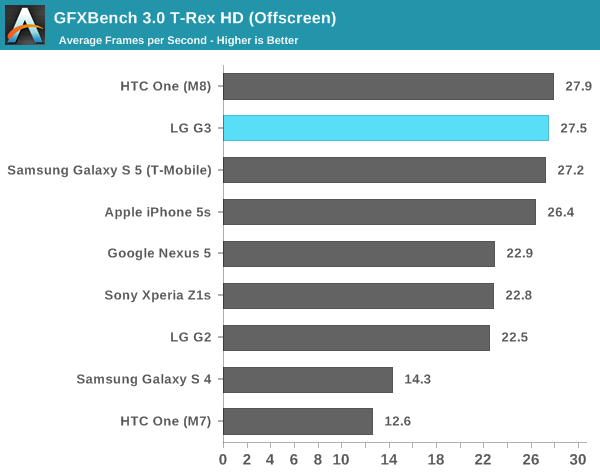
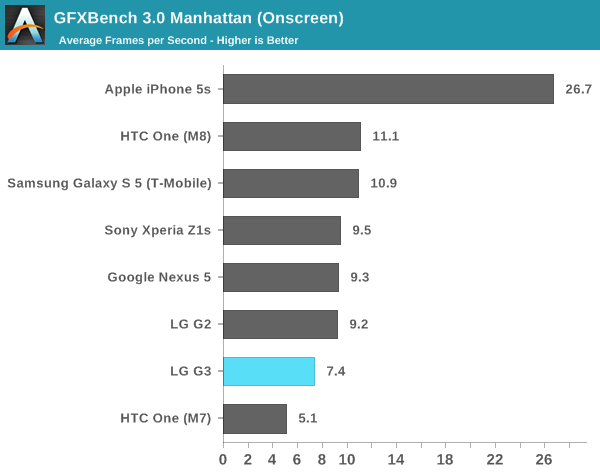
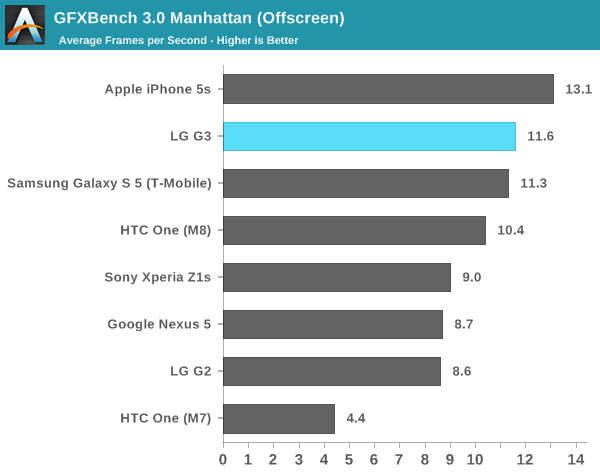
Here, we can see a noticeable trend. In the short tests, the LG G3 does great, easily nearing the top of the scores. However, 3DMark's extremely long-running test means that the G3 noticeably suffers in performance compared to the competition, and this is worsened by the G3's sinusoidal throttling patterns that cause significant degradation of performance for periods of time to balance out the high performance periods. On the on-screen tests, the G3 does worse than the high-end competition, which suggests that QHD/1440p truly does need Snapdragon 805's Adreno 420 in order to keep real-world performance from regressing relative to the Snapdragon 801, 1080p-screened counterparts.
NAND Performance
NAND performance used to be an afterthought, and effectively never discussed in most reviews. However, after the original Nexus 7 revealed the headaches that come with poor I/O performance this metric has increasingly come under greater scrutiny. To quantify this performance, we turn to Androbench with custom settings to evaluate Android smartphones.
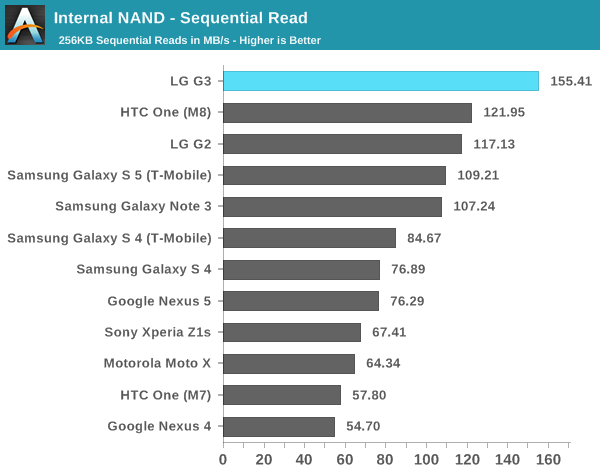
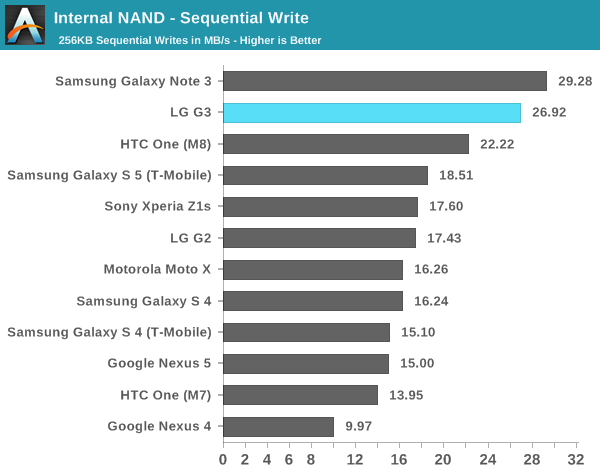
Here, the G3 is off to a great start. The sequential read speeds set new records and sequential write speeds are almost as good as it gets. This means that LG isn't cheaping out on NAND, which means that shooting 4K video and similarly intensive situations won't be a problem on the G3. However, random I/O performance is much more important as that's where people will notice poor performance in the form of stuttering and pauses.

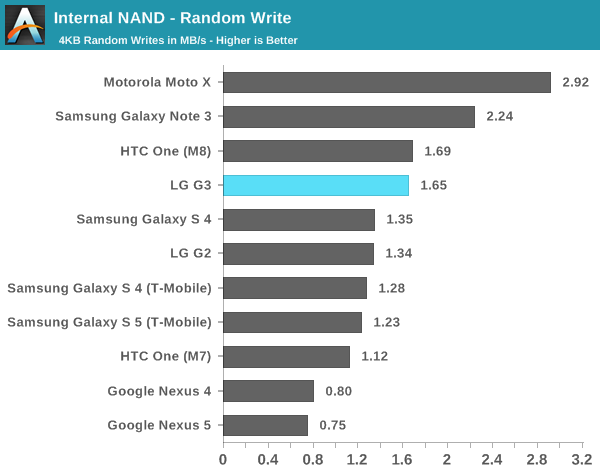
Here, we see a similar pattern. The LG G3 does great in random reads, but random write isn't quite as great. It's still perfectly usable and shouldn't present any problems for smoothness or general performance. The Moto X continues to hold its considerable lead here due to its F2FS file system that allows for much faster random I/O performance. Overall, the LG G3 shouldn't have any issues with I/O pauses, although you should still keep around 25% of your storage open to keep up I/O performance.










174 Comments
View All Comments
boe - Thursday, July 10, 2014 - link
This is a nice review but it would be great if the battery life chart showed talk time. I know it is crazy, but I use my phone to make phone calls.AncientWisdom - Thursday, July 10, 2014 - link
No way! oOHrel - Thursday, July 10, 2014 - link
Pretty glad I got the G2 this year, this phone sucks. 5.5" really? The G2 is already a bit too large and I have huge hands. 4.7" is probably the ideal size. They need to stop going beyond that.Perhaps because of LG's slim bezel chassis they can go larger, but certainly no larger than 5".
CampoX - Friday, July 11, 2014 - link
I was up for a G3 but after my Ultra died in my pocket this review was the reason I went for an M8 this week.goobersnatcher - Saturday, July 12, 2014 - link
If LG would have kept the size of the G2 and went 1080, QC 805 and made it the next Nexus .... I'd be all over this phone!andredogg - Tuesday, July 15, 2014 - link
Just bought this phone 4 days ago and I must admit it grows on you quickly. Selfie cam looks like a mirror my s5 active selfie cam is not in same league. And if your LG g3 is dim turn off auto brightness. Also like that every icon can be replaced by any pic or icon you find by holding down icon and releasing it and touching little paintbrush. overall experience is great. Also the 2k screen is amazing if you find content to play on it. Knock codes are also useful.yvn - Tuesday, July 15, 2014 - link
I had a chance to check out the display of LG G3 yesterday and oddly I have to disagree with Anand on its color reproduction. Not sure about the charts and other tests he did but it extreme close in color reproduction to my iPhone 5s and with just a tad more on red tones but then I know the iPhone 5s has a little weakens with reds and greens hues, so in other words the colors on G3 is spot on! hmm....Samsung even in "movie" mode looks way off so I am not sure how Anand claims in the review that Samsung has best display??? I am sure it is not so!soldier4343 - Thursday, July 17, 2014 - link
Handled one yesterday in store and its a great device. Waiting for the Note 4 in September to see what changes they made before upgrading which I do once a year.SpartyOn - Saturday, July 19, 2014 - link
Not a single Windows Phone for battery life comparison. It's like being a parent: I'm not upset... just... disappointed.Thanks Anandtech for continuing to promote a mobile phone OS duopoly.
deV14nt - Sunday, July 20, 2014 - link
I'm surprised the Galaxy S5 brightness was not measured with auto on. DisplayMate measured the max brightness at 698 nits with auto on, the brightest display they've tested, beating out the Note 3 by about 50 nits.It also would have been nice to see the G3 auto focus tested at less than 2 feet, to see the laser AF at its best conditions.